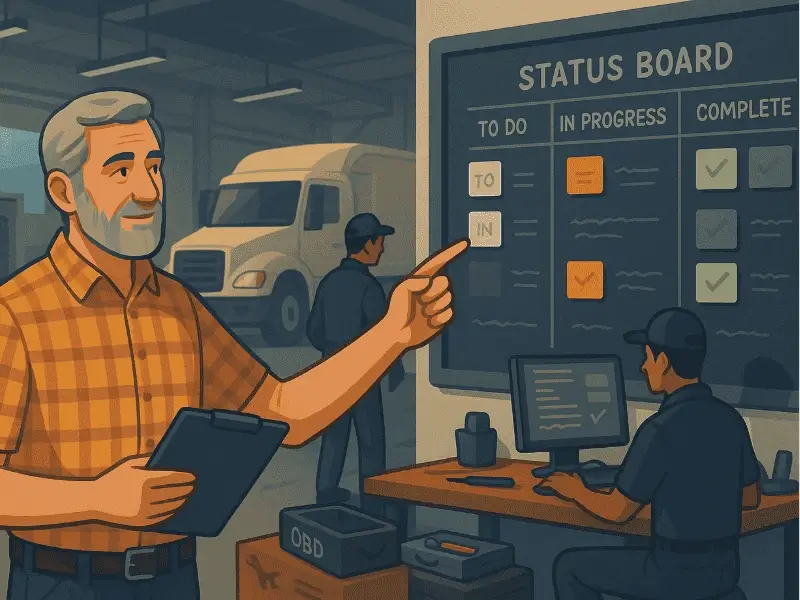Key Takeaways
- Work order backlog grows when priorities are unclear, repairs stall, and visibility is low.
- SLAs create structure by defining response times, repair deadlines, and escalation rules.
- Status boards create real-time visibility so managers, dispatchers, and technicians know exactly what’s pending, blocked, or at risk.
- A clear SOP (daily reviews, proper assignments, and complete work orders) keeps the backlog from returning.
- Using a platform like Simply Fleet automates updates, SLA alerts, technician load balancing, and status tracking to prevent delays.
Work order backlog might not feel urgent until it suddenly is. A few delayed repairs turn into a full week of bottlenecks. Vehicles start piling up outside the shop. Drivers complain about downtime. Dispatchers scramble to reshuffle schedules. And managers feel stuck between customer commitments and repair delays.
Backlog rarely comes from one big issue. It’s a combination of slow communication, incomplete work orders, unclear priorities, and a lack of real-time visibility. The result? Hours of lost productivity and vehicles staying off the road far longer than necessary.
What sets top-performing fleet operations apart is not more technicians or bigger budgets, it’s better workflow design. And two of the most powerful tools in that design are SLAs and status boards.
The Real Impact of Backlog: What the Numbers Reveal
Backlog doesn’t affects every touchpoint in a fleet-driven business. The ripple effect is real:
- Missed customer deadlines force dispatchers to reshuffle planned jobs.
- Vehicles waiting in the shop interrupt rental schedules and route commitments.
- Technicians waste time trying to figure out what to do next.
- Managers lose visibility into which repairs are stuck or overdue due to lack of proper reporting.
- Downtime costs skyrocket, especially in construction, HVAC, and car rental, where every hour matters.
Industry trends show that many fleets operate with 30–50% more backlog than their teams can realistically handle.
Where Backlog Begins: Hidden Bottlenecks in Fleet Repair Workflows
Most backlog problems come from avoidable friction points:
- Unclear priority levels: When everything is labeled “urgent,” technicians waste time deciding what to do first.
- Incomplete work orders: Lack of photos, diagnostics, or parts information forces techs to pause, ask questions, or wait.
- No SLA expectations: When nobody knows the target completion time, delays become normal.
- Verbal or ad-hoc assignment: Dispatchers assign work through calls, messages, or in-person conversations—easy to forget or misunderstand.
- No visual workflow: Without a board, no one knows which repairs are stuck, blocked, or about to breach a promise.
- Reactive follow-ups: Managers chase updates only after customers or drivers complain.
How SLAs Bring Structure, Predictability & Discipline
A Service Level Agreement (SLA) establishes clear timelines and rules for every type of repair. Instead of vague promises, you get predictable outcomes.
- They force clarity: Teams define what “critical,” “high,” or “low priority” actually mean.
- They create measurable expectations: Everyone knows when a job should be started and completed.
- They improve technician planning: Techs focus on the right job at the right time.
- They unlock accountability: A breach is visible instantly, not days later.
Building SLAs for Your Fleet: A Practical Blueprint
Strong SLAs should include:
1. Work Order Categories
- Critical: vehicle is unsafe or non-operational
- High: can operate but with restrictions
- Medium: planned repairs
- Low: cosmetic or non-impact issues
2. Timeline Expectations
- Critical → respond within 15 minutes, finish within 4–8 hours
- High → same-day response, 24-hour completion
- Medium → completion within 3–5 days
- Low → complete in 7–10 days
3. Communication Rules
- Critical jobs require updates every few hours
- Medium/low jobs require daily updates
4. Escalation Steps
- Automatic escalation when work order exceeds SLA time
- Supervisor notified
- Job gets re-routed or rescheduled
When SLAs are consistent, backlog naturally stays under control.
Status Boards: Visibility That Stops Backlog Before It Starts
SLAs provide structure but status boards make that structure impossible to ignore.
A status board is usually Kanban-style, showing every work order’s current stage. When placed on a shop wall or shared digitally, it becomes the heartbeat of your repair workflow.
- No more asking “what’s the status?”
- You can spot overdue repairs instantly, ensuring fleet safety.
- Technicians know their next task without waiting for instructions.
- Dispatchers can route work based on load and priority.
- Managers see what’s stuck, why, and for how long.
Think of the board as your "backlog pressure gauge." If the board stays clean and flowing, your backlog stays under control.
Recommended Board Columns (Perfect for Fleet Shops)
New → Approved → Waiting for Parts → Assigned → In Progress → On Hold → QA → Completed
Why this layout works
- Keeps waiting-for-parts delays visible
- Separates approval from assignment
- Highlights jobs that techs haven’t claimed yet
- Shows “On Hold” jobs clearly so they don’t disappear into backlog
- Tracks vehicles coming out of repair through QA
Building a Fleet SOP That Eliminates Backlog for Good
A strong SOP for fleet management connects your SLAs and your status board into a repeatable daily rhythm.
Daily Workflow Checklist
At the Start of the Day
- Review all active work orders
- Identify SLA risks
- Assign high-priority work first
- Balance loads across technicians
During the Day
- Update the board as soon as work begins or pauses
- Log parts delays immediately
- Communicate ETA shifts clearly
End of Day
- Review stuck jobs
- Update SLA exceptions
- Close out completed work orders entirely
This rhythm prevents backlog from sneaking up unexpectedly.
KPIs That Keep Backlog Under Control
Tracking a few core KPIs helps you detect problems before they grow:
Want a simpler way to manage work orders, reduce downtime, and eliminate backlog? Try Simply Fleet, your all-in-one system for work orders, technician assignments, real-time status tracking, and SLA enforcement.



.png)








.png)


.png)

.webp)
.webp)


.png)



